Power of the Wind
Wind is the fastest growing source of electricity in the world.
Share this:
- Share via email (Opens in new window) Email
- Click to share on Facebook (Opens in new window) Facebook
- Click to share on X (Opens in new window) X
- Click to share on Pinterest (Opens in new window) Pinterest
- Click to share on Reddit (Opens in new window) Reddit
- Share to Google Classroom (Opens in new window) Google Classroom
- Click to print (Opens in new window) Print
By Emily Sohn
On a breezy day, you can feel the wind in your hair, on your face, against your body. It tickles, pushes, or slams into you, depending on how hard it’s blowing. When it’s windy, you can fly a kite or go sailing.
 |
|
The power of the wind can send a kite into the sky—or supply electricity to homes. |
Wind is also an increasingly valuable source of energy—helping to bring electricity into our lives. Without electricity, there’d be no TV, no video games, and no cell phones. We’d have to sit around fires for warmth and eat dinner by candlelight.
At the National Wind Technology Center (NWTC) in Golden, Colorado, scientists are working to improve wind-power technology and lower the cost of generating electricity. The center is part of the National Renewable Energy Laboratory, where researchers look for Earth-friendly ways to power our lives.
A renewable natural resource is one that can’t be used up or one that can be replaced naturally. Sunlight is an example of a renewable resource that’s always available somewhere, and wood is an example of one that can be replaced by new growth. Wind is also a renewable resource.
Wind is the fastest growing source of electricity in the world. It’s often one of the least expensive forms of renewable power available. And it can sometimes be the cheapest form of any kind of power, some experts say.
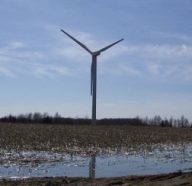 |
|
A modern windmill, like this one in a field in Pennsylvania, has three, streamlined blades for catching the wind and generating electricity. |
| Roger Czerneda |
Generating power from the wind leaves no dangerous waste products behind, says NWTC’s Jim Johnson. Best of all, its supply is unlimited.
“It sounds almost trite to say, but it’s true,” Johnson says. “The wind is always blowing somewhere.”
Catching the breeze
The idea behind wind power is simple. Like pinwheels, windmills are designed to catch breezes, which cause their blades to spin. This motion represents energy, which can then be used or converted into other forms of energy.
People have been harnessing the power of wind for a long time. Some of the first windmills were built more than 5,000 years ago, Johnson says, starting in the Middle East. Back then, people used wind to turn blades that rotated grinding stones that crushed grain into flour.
In the Netherlands, wind power has long been used to pump water. In the United States, a lot of windmills for pumping water, milling grain, and other purposes were built between 1870 and 1930. You can still see them on farms in some parts of the country.
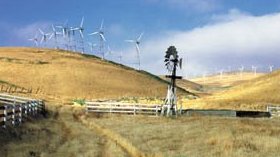 |
|
Fifty or more years ago, farmers used windmills like the one shown in the foreground to pump water. Nowadays, farms might have rows of wind turbines generating electricity, which is sold to power grids. |
| Warren Gretz, National Renewable Energy Laboratory |
Old windmills were usually made of wood and had any number of blades. Modern windmills, also called wind turbines, come in a variety of styles and sizes. They’re usually tall, skinny, and made of aluminum or steel. Most have two or three blades that spin on an axle, which is attached to a gearbox.
Nowadays, the blade motion is often converted into electrical energy.
“Think of a small, oscillating fan that you might put on your dresser or desk to make a breeze,” Johnson says. A windmill does the same thing that a fan does—but in reverse. “Instead of consuming energy to power the motor and turn the fan blades, the breeze turns the fan blades, which run a generator that produces electricity,” he says.
The average turbine has blades that carve out a circle about 150 feet wide, Johnson says. The biggest ones have blades that sweep out a circle stretching some 400 feet across. That’s a full football field and a half!
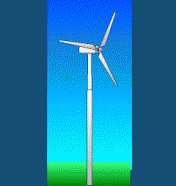 |
|
Modern windmills, also called wind turbines, are usually tall, skinny, and made out of aluminum or steel. Most have two or three blades that spin on an axle, which is attached to a gearbox. |
A turbine’s height depends on its location. Its blades have to catch gusts at the height above the ground at which the wind tends to be strongest. Some turbines are more than 100 feet tall.
But there’s more to generating electricity than just catching the wind. For one thing, the electricity generated by a windmill has to be converted to different voltages and frequency levels before it can flow through power lines. And, because storing this energy would be inefficient, electricity generated by wind goes directly into the power grid, where it mixes with electrical energy from other sources.
Potential power
The potential for wind power is huge, advocates say.
Right now, the United States gets less than one-tenth of a percent of its electricity from wind energy, Johnson says. Some experts say it’s possible to boost that number to 20 percent—or more.
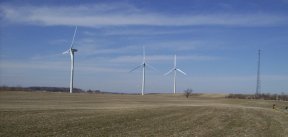 |
|
A wind farm in Pennsylvania. |
| Roger Czerneda |
In theory, North Dakota alone could supply one third of the country’s energy if there were an efficient way to transport the energy to where it’s needed, say experts at the American Wind Energy Association.
The U.S. Department of Energy estimates that the world’s winds could generate 15 times the amount of energy now used around the globe, if only we could tap into them.
Even so, wind energy has its critics, who argue that the system is far from perfect. One of the biggest problems with wind, they say, is its unreliability. Though the wind might always be blowing somewhere at any given time, there’s no guarantee that it would blow all the time at any given place.
The faster and more often the wind blows, the cheaper and easier it is to extract power from it, so wind farms tend to pop up in the windiest places. In the United States, that means states in the Midwest, such as Minnesota and Kansas. California also has large wind farms.
Unfortunately, these places tend to be far from the biggest concentrations of people, who live mostly in cities on the coasts. There’s still no good way to transport wind energy over long distances.
Ugly turbines
Another criticism of wind turbines is more personal. Wind farms take up a lot of space, and some people think they’re just plain ugly.
One of the most controversial projects right now has been proposed for Nantucket Sound, off the coast of Cape Cod in Massachusetts (see www.capewind.org/). Offshore wind farms can be highly productive because the breezes out on the ocean are consistently fierce, but the United States has yet to get one built.
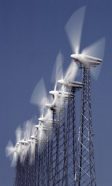 |
|
People who oppose wind farms argue that turbines can be noisy, spoil the scenery, harm birds, bats, and other animals, and might even change the local climate. |
| PhotoDisc |
However, some people, including Massachusetts Governor Mitt Romney, are worried that an offshore wind farm would ruin the natural beauty of the area.
Johnson disagrees. “Ugly is in the eye of the beholder,” he says. “It’s ugly if you’re a ‘Not in My Backyard’ kind of person.” People who support renewable energy, on the other hand, often think wind turbines are beautiful.
Other people have complained that wind turbines can be noisy, could affect bird migration, and cause the deaths of bats and other animals. One recent report suggested that large wind farms could even affect an area’s local climate.
Paul White owns a wind-power development company in Minneapolis called Project Resources Corporation. He sees great value in the wind-energy business.
“My whole life has been powered by wind power for over 10 years,” White says. “Everything I purchase, drive, sleep on, read, and eat was paid for by the proceeds from selling electricity generated by the wind. Everything.”
“I’ll be living off of wind power the rest of my life, as will all of my employees and their families, assuming the wind keeps blowing, which I’m willing to bet on,” he adds.
There’s still a lot of research to be done on making sure that wind power does it job efficiently, safely, and cheaply. That’s where the engineers and other researchers at NWTC and elsewhere come in.
And that’s where you can make a contribution if you do a science project involving wind energy and turbines (see www.kidwind.org/materials/sciencefairideas.html).
Wind power has the potential to ease the world’s dependence on fossil fuels and to help clean up the environment. It’s worth the effort.
Going Deeper:







